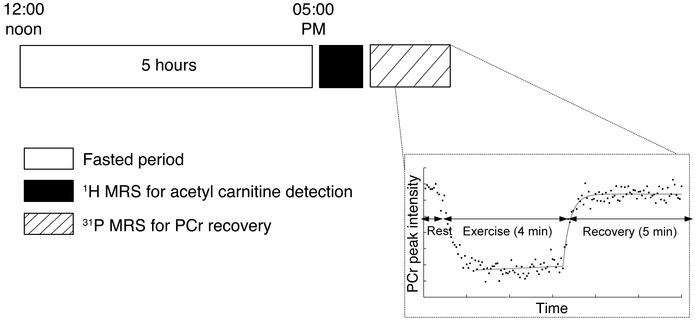Citation Information: J Clin Invest. 2014;124(11):4915-4925. https://doi.org/10.1172/JCI74830.
Abstract
Animal models suggest that acetylcarnitine production is essential for maintaining metabolic flexibility and insulin sensitivity. Because current methods to detect acetylcarnitine involve biopsy of the tissue of interest, noninvasive alternatives to measure acetylcarnitine concentrations could facilitate our understanding of its physiological relevance in humans. Here, we investigated the use of long–echo time (TE) proton magnetic resonance spectroscopy (1H-MRS) to measure skeletal muscle acetylcarnitine concentrations on a clinical 3T scanner. We applied long-TE 1H-MRS to measure acetylcarnitine in endurance-trained athletes, lean and obese sedentary subjects, and type 2 diabetes mellitus (T2DM) patients to cover a wide spectrum in insulin sensitivity. A long-TE 1H-MRS protocol was implemented for successful detection of skeletal muscle acetylcarnitine in these individuals. There were pronounced differences in insulin sensitivity, as measured by hyperinsulinemic-euglycemic clamp, and skeletal muscle mitochondrial function, as measured by phosphorus-MRS (31P-MRS), across groups. Insulin sensitivity and mitochondrial function were highest in trained athletes and lowest in T2DM patients. Skeletal muscle acetylcarnitine concentration showed a reciprocal distribution, with mean acetylcarnitine concentration correlating with mean insulin sensitivity in each group. These results demonstrate that measuring acetylcarnitine concentrations with 1H-MRS is feasible on clinical MR scanners and support the hypothesis that T2DM patients are characterized by a decreased formation of acetylcarnitine, possibly underlying decreased insulin sensitivity.
Authors
Lucas Lindeboom, Christine I. Nabuurs, Joris Hoeks, Bram Brouwers, Esther Phielix, M. Eline Kooi, Matthijs K.C. Hesselink, Joachim E. Wildberger, Robert D. Stevens, Timothy Koves, Deborah M. Muoio, Patrick Schrauwen, Vera B. Schrauwen-Hinderling
Figure 8



Copyright © 2024 American Society for Clinical Investigation
ISSN: 0021-9738 (print), 1558-8238 (online)

